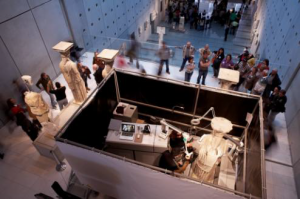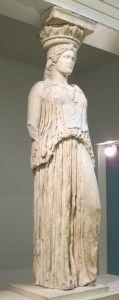The New York Times Presents The Acropolis Maidens – The Caryatid Statues

The renowned Caryatids in the Acropolis Museum. The figures were originally six but one was removed by Lord Elgin in the early 19th century and is now in the British Museum in London. The pedestal for the Caryatid removed to London (second from the left on the front) remains empty.
The renowned Caryatid statues that stood atop the Acropolis for 2,500 years and are now the “star attractions” of the Acropolis Museum are presented in an article in The New York Times.
In her article, journalist Liz Alderman, introduces the Caryatid restoration project that was recently completed, coinciding with the five-year anniversary of the museum.
“For 2,500 years, the six sisters stood unflinching atop the Acropolis, as the fires of war blazed around them, bullets nicked their robes, and bombs scarred their curvaceous bodies. When one of them was kidnapped in the 19th century, legend had it that the other five could be heard weeping in the night.” – The New York Times
As noted in the article, over the centuries, a coat of black grime came to mask their beauty and for the past three and a half years, conservators at the museum have been cleaning the maidens. “Ionic columns in female form believed to have been sculpted by Alkamenes, a student of ancient Greece’s greatest artist, Phidias,” the New York Times noted.
Today, thanks to a specially developed laser technology, five of the six statues have been restored to their “original ivory glow.
“The missing Caryatid is installed at the British Museum in London, which acquired it nearly two centuries ago after Lord Elgin, the British ambassador to the Ottoman Empire, had it sawed off the Erechtheion’s porch, along with shiploads of adornments from the Parthenon to decorate his mansion in Scotland before selling the pieces to pay debts.” – The New York Times
Further in the article, journalist Liz Alderman refers to the dispute between Greek and British authorities over the return of these so-called Elgin marbles to Athens.
“It’s been 200 years… We think in the framework of the new museum, it’s possible to reunite our treasures,” Dimitris Pantermalis, the president of the Acropolis Museum, told the journalist.
To read the whole article, press here.






